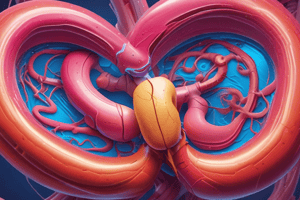Podcast
Questions and Answers
Which statement correctly describes the pathogenesis of renal cell carcinoma?
Which statement correctly describes the pathogenesis of renal cell carcinoma?
- Renal cell carcinoma primarily arises from mesenchymal tissues.
- Loss of the VHL tumor suppressor gene leads to a decrease in IGF-1 levels.
- Loss of the VHL tumor suppressor gene results in increased levels of HIF transcription factor. (correct)
- Increased levels of VEGF and PDGF cause the suppression of tumor growth.
What is the most common clinical symptom of renal cell carcinoma?
What is the most common clinical symptom of renal cell carcinoma?
- Weight loss
- Hematuria (correct)
- Palpable mass
- Flank pain
Involvement of the left renal vein by carcinoma is most likely to lead to which condition?
Involvement of the left renal vein by carcinoma is most likely to lead to which condition?
- Left-sided varicocele (correct)
- Right-sided varicocele
- Renal vein thrombosis
- Hematogenous spread to the liver
Which demographic is most commonly affected by sporadic renal cell carcinoma?
Which demographic is most commonly affected by sporadic renal cell carcinoma?
Which statement is true regarding Wilms tumor?
Which statement is true regarding Wilms tumor?
Which histological feature is most characteristic of the common variant of renal cell carcinoma?
Which histological feature is most characteristic of the common variant of renal cell carcinoma?
Which of the following is a classic symptom associated with Wilms tumor?
Which of the following is a classic symptom associated with Wilms tumor?
What distinguishes a hereditary Wilms tumor from a sporadic case?
What distinguishes a hereditary Wilms tumor from a sporadic case?
Flashcards
What is an Angiomyolipoma?
What is an Angiomyolipoma?
A benign tumor of the kidney composed of blood vessels, smooth muscle, and fat tissue. It is often associated with the genetic disorder tuberous sclerosis.
What is Renal Cell Carcinoma?
What is Renal Cell Carcinoma?
A type of kidney cancer that arises from the epithelial cells of kidney tubules. Classic symptoms include blood in the urine (hematuria), a palpable mass in the flank, and flank pain, though all three symptoms occur rarely together.
What is the Pathogenesis of Renal Cell Carcinoma?
What is the Pathogenesis of Renal Cell Carcinoma?
Mutations in the VHL gene, a tumor suppressor gene, leading to increased levels of IGF-1, which promotes cell growth, and increased HIF transcription factor, which stimulates the production of VEGF and PDGF, promoting blood vessel formation.
What is a Wilms Tumor?
What is a Wilms Tumor?
Signup and view all the flashcards
What is WAGR Syndrome?
What is WAGR Syndrome?
Signup and view all the flashcards
What is Denys-Drash Syndrome?
What is Denys-Drash Syndrome?
Signup and view all the flashcards
What is Beckwith-Wiedemann Syndrome?
What is Beckwith-Wiedemann Syndrome?
Signup and view all the flashcards
Study Notes
Renal Neoplasia
- Angiomyolipoma:
- A hamartoma composed of blood vessels, smooth muscle, and adipose tissue.
- Increased frequency in tuberous sclerosis.
- Renal Cell Carcinoma:
- A malignant epithelial tumor originating from kidney tubules.
Additional Renal Tumor Information
- Classic triad of renal tumors:
- Hematuria, palpable mass, and flank pain (rarely occur together).
- Fever, weight loss, or paraneoplastic syndromes (EPO, renin, PTHrP, or ACTH) may be present
- Left-sided varicocele:
- Possible complication from blockage of the left renal vein by carcinoma.
- Left spermatic vein blockage causes varicocele.
- Right spermatic vein drains into the IVC; thus preventing a right-sided varicocele.
- Gross and microscopic appearance:
- Yellow mass microscopically shows clear cytoplasm (clear cell type) in the most common variant.
- Pathogenesis (Renal Cell Carcinoma):
- Involves loss of the VHL (3p) tumor suppressor gene.
- Leads to increased IGF-1, promoting growth.
- Increased HIF transcription factor for VEGF and PDGF
- Tumor types:
- Sporadic:
- Common in adult males (average age 60).
- Typically single tumor in the kidney's upper pole.
- Cigarette smoking is a risk factor
- Hereditary:
- Arises in younger adults.
- Typically bilateral tumors.
- Von Hippel-Lindau disease: Autosomal dominant linking to VHL gene inactivation and increased risk for hemangioblastoma of the cerebellum and renal cell carcinoma.
- Sporadic:
- Staging:
- T-stage: based on size and involvement of the renal vein
- Risk of spread to the lungs and bones
- N-stage: spread to retroperitoneal lymph nodes
- T-stage: based on size and involvement of the renal vein
Wilms Tumor
- A malignant kidney tumor, composed of blastema, primitive glomeruli, tubules and stromal cells.
- Most common malignant renal tumor in children (average age 3 years).
- Presents with a large, unilateral, flank mass, hematuria and hypertension.
- 90% are sporadic, some are syndromic:
- WAGR syndrome: Wilms tumor, aniridia, genital abnormalities, mental and motor retardation, linked to a deletion of the WT1 tumor suppressor gene (11p13).
- Denys-Drash syndrome: Wilms tumor, progressive renal disease, and male pseudohermaphroditism, related to WT1 mutations.
- Beckwith-Wiedemann syndrome:
- Wilms tumor, neonatal hypoglycemia, muscular hemihypertrophy, and organomegaly (including tongue).
- Associated with mutations in the WT2 gene cluster (imprinted genes at 11p15.5), particularly IGF-2.
Studying That Suits You
Use AI to generate personalized quizzes and flashcards to suit your learning preferences.




